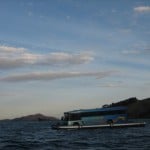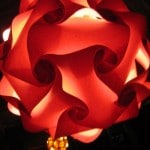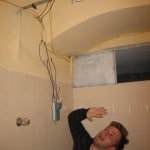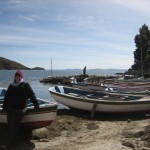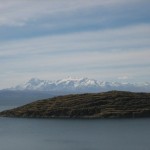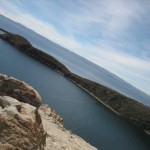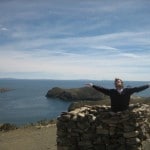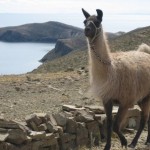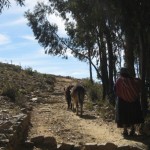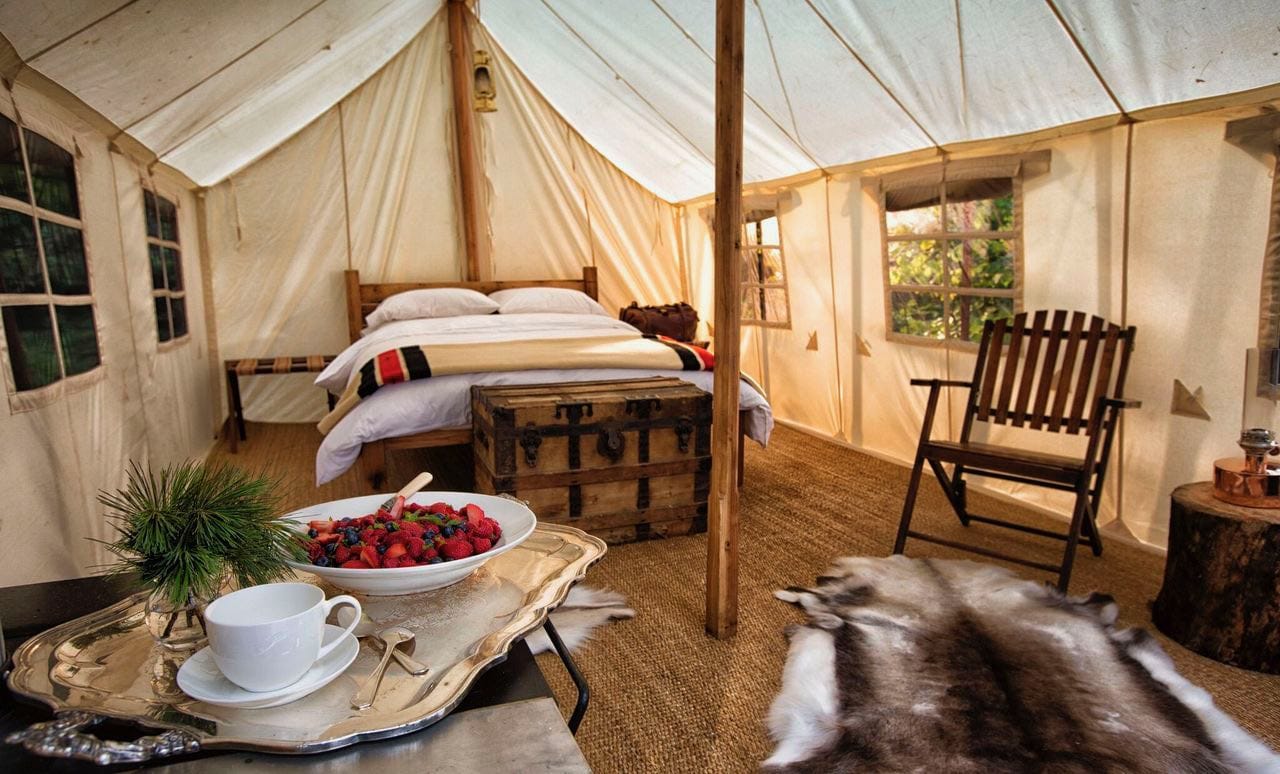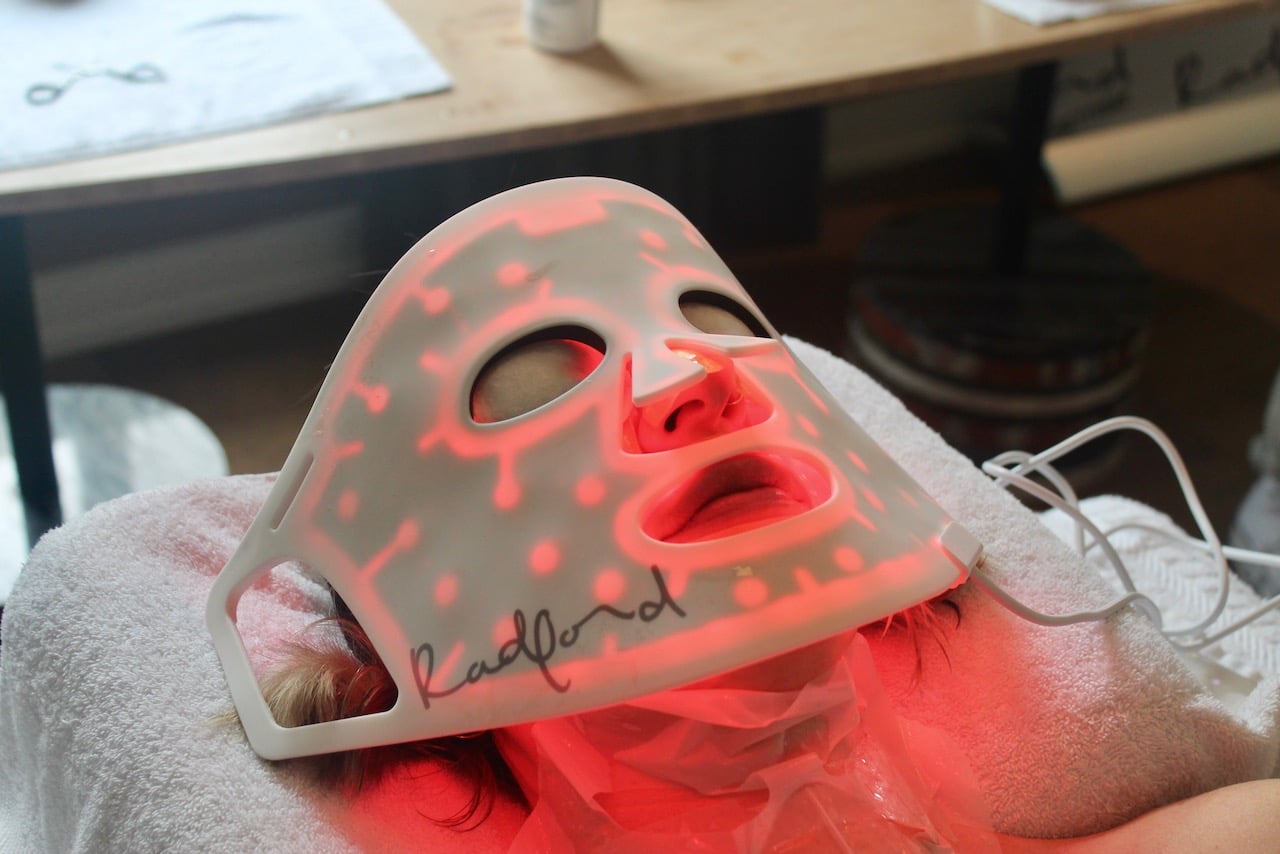We hopped off our plane and jumped onto a cheap collectivo through the dirty city of El Alto. We arrived at a makeshift bus stand and waited for the bus from La Paz to arrive. The dichotomy of rich and poor here is the opposite of what you see in most cities. Usually the poor live in the center of big cities whereas the rich live in the heart of La Paz and the poor live up on the cliff in El Alto. The reason for this is that La Paz is warm and El Alto is freezing. The rich love their warm temperatures apparently.
We hopped on a five hour bus to Copacabana after waiting a short five minutes. The prices here still amaze me. A five hour bus cost us a wee two dollars. We were rather impressed with the condition of this Bolivian bus. I stared out the window at the hectic streets pouring over with market vendors. Many parts of the muddy street appeared to look like a disorganized parking lot. I stared out into the rolling green hills of the outer city limits and ended up falling asleep for three hours. I awoke to realize that our bus was being sniffed out by drug dogs. We had arrived in the small town of Tiquina. We were all instructed to leave the bus and jump onto a ferry to cross the river. Our bus drove onto a flat makeshift ferry which slowly made its way to the other side of the river to meet us. We found it rather hilarious to watch a bus jostling to and fro on top of the rolling waves. Sarah and I both sat at the rear of the boat and were a bit freaked out as we could see through the floor boards. A group of three men stared at Sarah and I as if they had never met a white person in their entire lives. We stared at them back, awkward moments on the rolling river.
On the other side of the river we waited for our bus to arrive and weaved through several market stands. My heart jumped out of my throat and I went a bit manic when I saw a huge tube of Salt and Vinegar Pringles. It could not be! I instantly purchased the tube of savory potato goodness. Our bus climbed steep cliff faces as the beautiful sun decided to set across the moon bright southern end of Lake Titicaca. We arrived in the small town of Copacabana and walked down the main street past a foul smelling meat market. As we walked down the main hotel and restaurant avenue we laughed as a remix of Celine Dion’s Titanic anthem, My Heart Will Go On was playing over a blaring set of speakers.
We ate dinner at Playa Azul Restaurant. We decided to share a plate of Lake Titicaca world famous trout (Lake Titicaca has the worlds largest trout species which looks and tastes like a perfect Salmon steak). Everything inside the restaurant was made of dried Lake Titicaca reeds. We listened to native music as we glanced through our menu and toasted our bodies by the restaurants central wood burning stove. I ordered a bowl of Quinoa soup, a plate of fried chicken with fries and shared a traditional trout steak with lemon butter. We walked back to our hostel which was rather ghetto. I guess that’s what you should expect when a private bedroom costs 4 USD. Sarah commented that the room reminded her of the typical grungy hotel room where people end up getting murdered in spy films. Sarah grabbed the double bed while I was stuck with the lonely single. When she was finally ready for bed we both started laughing as she sunk into the middle of the bed. On the other hand my bed felt as though it was made of slate so we both ended up having rather horrid sleeps.
In the morning we walked down to the docks and grabbed a ferry to the famous Inca Isla del Sol (Island of the Sun). We sat on the roof of the ferry and stared at the clouds of air that came from our mouths. It was a freezing cold morning at the top of the highest navigable lake on earth. The lake has an elevation of 3820m, is 230 km long and 97 km wide. You can see traditional Aymaran villages along the shore as the ferry slowly makes it way to the island. The Island of the Sun is surrounded by ancient legends and the snow topped mountain peaks of the Cordillera Real which provide a magical landscape for the two hour sail. Isla del Sol is where you can find the ancient legendary Inca creation site and birth place of the sun in Incan mythology. The population of the island is a mere 5000 people. We stared out at the shimmering lake and tried to avoid looking directly into the blinding rays of the sun. The mountains on the island are deconstructed by man made plateaus which are used for agricultural purposes by local farmers. During the warmer months of the year you can see coca plants waving on the hillsides. Lush narcotics are a breeze.
We hopped off the boat and were greeted by a women who was herding a group of baby pigs across town. I also noticed several grey horned cows walking along the lapping shore. I sat down for a brief rest and soon three cute little local kids came up to me with big smiles on their faces. Sarah and I took a few cute pictures with them before walking through town and arriving at the start of our days hike. On the other side of town a gorgeous little bay features little fisherman’s row boats which are coloured with the stripes of the Bolivian flag. We crossed the sand filled shoreline and glanced down into the perfectly turquoise water lapping beside us. We started our one hour hike to the Chincana ruins at the north end of the island which is the site of the sacred rock where Incan creation legend began. The initial hike up the cliff overlooking the bay bellow and the town in the distance was stunning but also incredibly difficult as the altitude really took a tole on our ability to breath. We walked directly through small villages and patches of farmland. The rock on the island is a beautiful white stone, veined with orange and yellow streaks. I stared at two creepy looking albino cows with ghost white skin and pink eyes, an odd pair of farm animals that’s for certain. We overheard a tour guide mentioning that the deepest part of Lake Titicaca is 3000 meters! I can’t express in words how beautiful the many panoramic views from the island are. We found ourselves breathless from the beauty around us but attributed most of this heavy breathing to the altitude.
We arrived at a flat area between two mountainous peaks. Supposedly this is where creation rituals were conducted. Walking a little bit further we arrived at one of the most famous Inca sites in South America. This intact ruin was the home stay for all of the most important Inca Priests. This is the area where they would do healings and religious rituals. After walking under many short doorways (these people were apparently very small) and into a maze of rooms we walked back to a fork in the road. To the left we could walk back to the north end of the island and to the right we were told we could hike for three hours to the southern city of Yumani. Our intention was to pick up the boat in the morning from the south end of the island so we started our slow crawl. It took us about 25 minutes to walk a distance that would take less than five minutes without the altitude. We had to stop every few feet to catch our breath. Sarah looked as though she may die several times when I looked back at her she was breathing as if knives were being pounded into her lungs. It is a very odd sensation to breath but not acquire any oxygen. I felt drunk, dizzy and could barely walk in a straight line. This went on for five hours.
Yes, that’s right, the three hour hike took us five hours. The panoramic views we gawked at after each new winding cliff side climb was out of this world. The sun was pounding down on us. I think I understand why the Incas thought this area was the creation of the sun. It surely blazes here like fire on a regular basis. My ankles and feet started to ache as we barely experienced any flat walking paths. We were continuously hiking up rugged and rocky inclines. We kept saying to ourselves “maybe after we reach this peak the path will start to flatten out or go down.” Without a doubt every time we reached the top of a mountain peak our hearts sunk as we saw another long hike ahead. At the highest point of the island I stared out at the lake and shoreline beyond. I thought to myself how perfect this lake would be for a yacht race. Barely any of the lake is inhabited. When walking on the island you feel as though you are entirely alone, no boats on the water, and not a town in sight on the shoreline. When looking at the never ending path crawling across the cliff side hills it appeared to me that it looked somewhat like the Great Wall of China. Our path was well defined, flanked by one foot high rock fences.
We passed by a group of three local girls who ended up taunting us with their Llamas. They followed us down the path for several minutes telling us we must take a picture of their Llamas. Little girls can be scary. Totally exhausted, with lungs that burned in our bellies we finally took a deep aching breath when we were able to see the town of Yumani in the distance. From that point it took us another hour or so to actually reach our destination. As we started to walk down the mountain I realized that it can be just as difficult as walking up. My legs were exhausted by the time we reached the bottom of the valley where a group of young boys stood by a sheep farm. We took a picture of the sheep as we walked past the boys and they all came running after us with their hands outstretched screaming “pay me, pay me, you took a picture of our sheep!” With our backs aching, lungs exhausted, legs quivering we huffed and puffed the last cliff face to the outskirts of the town of Yumani. It is here where Sarah said “I feel so duped, I thought we had arrived finally and we still have 30 minutes to go!” This truly was the most demanding excursion of exercise I have ever experienced. It is hard to separate the pain in your body from the absolute beauty that surrounds you. We decided if we ever came back to the island in the future we would carry oxygen tanks at our sides.
A little boy started walking by our side as we walked into town. He told us about each hostel as we walked by the town center. We ended up staying at Hostal Puerto del Sol in a double room with a beautiful view of the lake from our window. We plopped down on our beds. It isn’t until you are off your feet that you truly realize how much pain your body is in. We were both exhausted but also realized we hadn’t eaten any food all day! We hobbled around town looking for a place to eat and ended up choosing a diamond in the ruff. A very small restaurant off the beaten path so to speak. We had to walk about ten minutes through a Eucalyptus forest before we arrived at our little pizzeria. The owners had just arrived with their food supplies (strapped on the backs of two donkeys). We sat inside at one of the four tables and watched the sun set across the lake. I ordered a Fanta with vodka (to numb that pain) and we both shared a large pizza with fried garlic, onion and chorizo. The owners told us that the island has only had electricity for the last three years! Apparently prices have sky rocketed for tourists since this modern convenience arrived. Not that we noticed! We walked back to the hostel in the pitch black with the full moon light as our guide. We stared out at the other end of the island which appeared as a pitch black silhouette with orange, yellow and pink sunset gleaming over its peaks. We both sat on the balcony staring up at the amazing expanse of stars before our aching bodies soon told us to sleep. We were in bed like two grannies at 7:30pm, waking up the next morning at exactly 7:30am. Apparently we required 12 hours of sleep!
In the morning we walked to a small restaurant for breakfast overlooking the water. We stared up at the many reed mobiles that dangled from the ceiling before ordering or Americano breakfasts which consisted of orange juice, cafe con leche, toast with jam and fried egg. After breakfast we started our steep walk down towards the islands southern beach port. We passed by several Llama and Donkey caravans. Apparently every morning boats from Copacabana bring goods to Yumani which have to be hauled up the mountain by these funny looking animals. We walked down a long 200 step boulder staircase which had a beautiful natural spring fountain at the top. A small canal on the right side of the stairs carried this spring water downhill like a gushing waterfall. We smelled the sweet aroma of thousands of yellow and white daisy gardens and stared up at huge ancient trees as the morning sun passed through their branches.
We hopped on a packed full ferry at 10am. The center of the boat had a pile (or pyramid) of backpacks. You could barely move or look over to the other side of the boat. Everyone on the ferry had sun burnt faces, a requirement when spending time on Isla del Sol. Our boat was barely above water as it was packed to over capacity. We glanced out the window and could see that the ferry was barely faster than a snails pace. We laughed at an old American Cowboy from Texas (around 60 years old) started talking to a family of indigenous islanders. He started handing them posters he bought featuring their president and a book full of Bolivian legends. He was talking incredibly loudly so everyone on board could here what he was saying. It was impossible not to laugh at him as these locals stared, wide eyed at books featuring stories from their own history!
We arrived in Copacabana at noon, bracing ourselves for the blazing sun. We walked up the hill back to our hostel while staring over the beach where many tourists were puttering around the bay in rented paddle boats. We arrived back at the hostel to pick up our laundry, a bad omen as we arrived. The man said ¨icarumba¨ when we told him we wanted our laundry now as we had to grab a bus soon to Puno Peru. He tells us to wait just a few minutes as he runs up the stairs and grabs our laundry. We are rather bothered at this point that our laundry isn´t done as he had two days to have it ready. We were even more irritated when he said once again ¨just a little more time¨ and proceeded to take our wet cloths out of a bag and place them in the sun over lawn chairs. We both darted out of our seats and told the man we had to vamos! He then started laughing like a hyena as we grabbed all of our cloths and grudgingly stuffed them in our bags.
We purchased a ticket to Puno Peru which is located on the north shore of Lake Titicaca. The bus left in an hour so we walked up to the main town square and took a few pictures of the green and blue mosaic cathedral. We loaded up on American candy: Snickers, Skittles, and Pringles. Side note; Bolivia is the only country in South America that sells American snacks. They do this for tourism sake. I think they get the impression that their food doesn´t impress tourists so they need our anglo creature home comforts at least. At the square I bought a neat wooden bracelet that featured antique pictures of the Catholic church and an Amazon tree nut ring. We arrived at our tourist bus just in time. After the short drive to the border we all lined up to have our passports stamped. I believe half of the line consisted of Israeli citizens. We walked across the border and celebrated when we arrived in Peru as we had survived Bolivia without a scratch! I exchanged my money at the border and celebrated with a Nestle ice cream. As we waited to get back on our bus a man came by selling cocaine candy and cookies.
For the next two hours we drove north along glistening Lake Titicaca. The shores full of shimmering golden reeds. The skies completely blue with the exception of a few puffy cotton white clouds.
